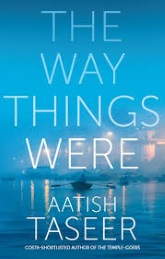The Way Things Were
Aaatish Taseer

Paperback: 565 pages Picador (2015) Language: English« Book Excerpts »US: Barnes & Noble, Book DepositoryUK: Foyles, Amazon.co.ukIN: Full Circle BookstorePK: Liberty Books |
Writer Aatish Taseer embodies much of the turmoil—emotional, intellectual and physical—that prevails in contemporary South Asia. His mother is the well-known Indian journalist Tavleen Singh and his father, the late Salman Taseer, Governor of Pakistan’s Punjab Province, was notoriously murdered in 2011 by his own bodyguards for standing up for justice in the application of Pakistan’s blasphemy laws. Taseer made his debut as a writer with his memoir, Stranger to History: A Son’s Journey Through Islamic Lands in 2009, a work which prompted VS Naipaul to declare him as “a writer to watch”. Taseer has since produced three works of fiction in quick succession that reflect the various kinds of tumult in his own life. The Temple Goers was shortlisted for the Costa First Novel Award in 2010 and Noon, a novel in the form of interlinked stories, followed in 2011. Taseer’s recently released The Way Things Were tells of the parallel lives of Toby, a half-Indian, half-Scottish scholar of Sanskrit and his son Skanda, two people connected as much through the language of Sanskrit as blood. The book opens with Toby’s death. Toby, the erstwhile Raja of Kalasuryaketu, had left India for good after his estrangement from Uma, his wife and Skanda’s mother. Skanda has followed in his father’s intellectual footsteps and is busy in Manhattan translating the text of The Birth of Kumara from Sanskrit to English. He has responsibility to bring his father’s body back to his birthplace and he is also entrusted with the task of immersing his father’s ashes in the holy river Tamasa. The story includes frequent flashbacks as Skanda recounts to Gauri, his new girlfriend in India, his family’s history and the doomed romance of his parents, and how their lives fell apart amidst major events in the country—the Emergency of 1975, Indira Gandhi’s assassination and the consequent anti-Sikh pogroms in 1984 and the demolition of the mosque at Ayodhya in 1992. Unlike most diasporic writers, Taseer’s novels are not focused on hyphenated identities or the angst of second or third-generation Indo-Brits or Indian-Americans. The Way Things Were instead focuses on history and its effects on the present. Taseer has, it seems, a genuine love of Sanskrit—a language even most Indians living in India look upon as defunct today. He delves deeply into linguistic “cognates” (words in different languages that share the same origins) and uses them as a device to connect father and son. Skanda is shown pondering: A game of cognates—a game his father had taught him—begins on the plane with the flight map. Distance to destination. Destination: gantavya. The place to be gone to. Gerundive of gam, an old Indo-European thread which takes little leaps of meaning as it travels west: turning go to come. In Gothic, qvam; in English, come; in Latin venio for gvemio… And when Toby, the father, is asked at a conference what the Ramayana means to him—myth or history?—he “replies with a smile”: Why not stick with the Indic definition? Of Itihasa! Which is a compound, as you know, iti-ha-asa, and when broken down, means, literally, The Way indeed that Things Were. That covers everything: talk, legend, tradition, history… This focus on language permeates the book, to the point that one critic has commented that Taseer’s “characters pale before cognates”, an observation that those who prefer stories over ideas might agree with. Taseer has reflected publicly that he believes in two kinds of people: those who are of the intellect and those who are not, a preoccupation which is reflected in almost all the characters in this novel; a few of them have been identified as caricatures of real-life “drawing-room” people from Lutyens’ Delhi: the elite from his mother Tavleen Singh’s circles. In a possible case of life imitating art, just before the novel appeared, Smriti Irani, India’s minister of Human Resource Development, announced a decision to re-introduce Sanskrit as a subject of study at school, replacing German, a move that generated considerable flak from the media and the public. Taseer himself spoke of it as an act of piety rather than an intellectual exercise. But in the book, language and its relationship with the past remains central, as Toby says: … if we were to associate the genius of a place with one particular thing—the Russians with literature, say, or the Germans with music, the Dutch and Spanish with painting—we would have to say that the true genius of Ancient India was language […] It changed my entire relationship with what remained of old India in India… Skanda, in the process, rediscovers his roots and comes to realize the role of his father in his own past and present: His father, when he was alive, had, no matter how nominally, embodied the past. But, with that body gone, it was as if he, Skanda, needed the child to come up in him from the depths of a buried past to merge with the adult, like a reflection rising to meet its object […] ‘Men need history,’ Naipaul tells us, ‘it helps them to have an idea of who they are. But history, like sanctity, can reside in the heart; it is enough that there is something there.’ Divya Dubey | 4 February 2015 | Asian Review of BooksReviewsAlfred Hickling | 27 Friday March | The Guardian
|
